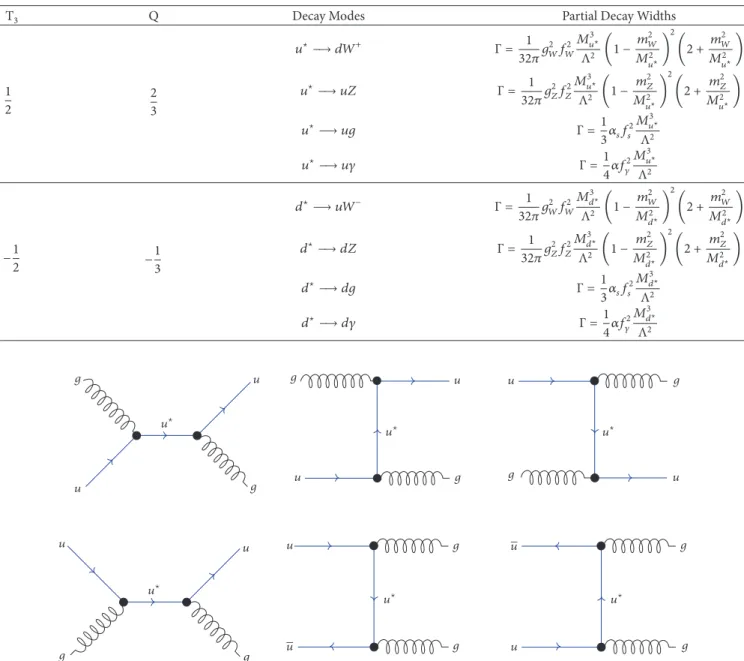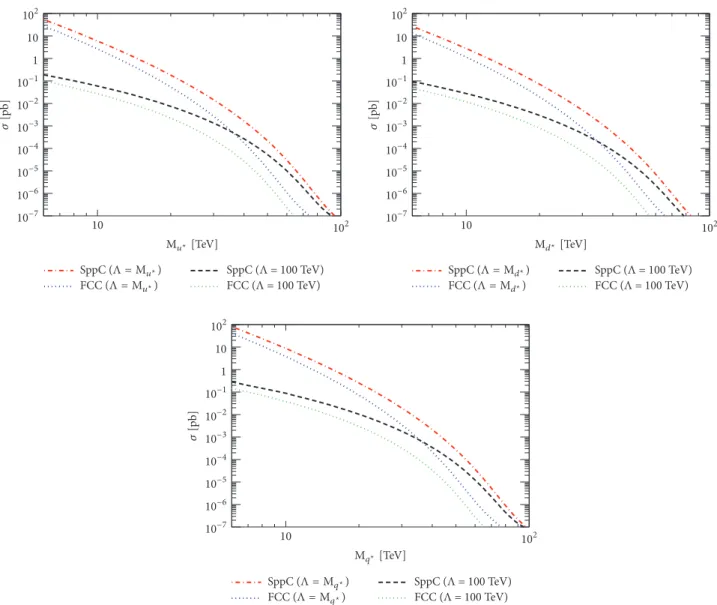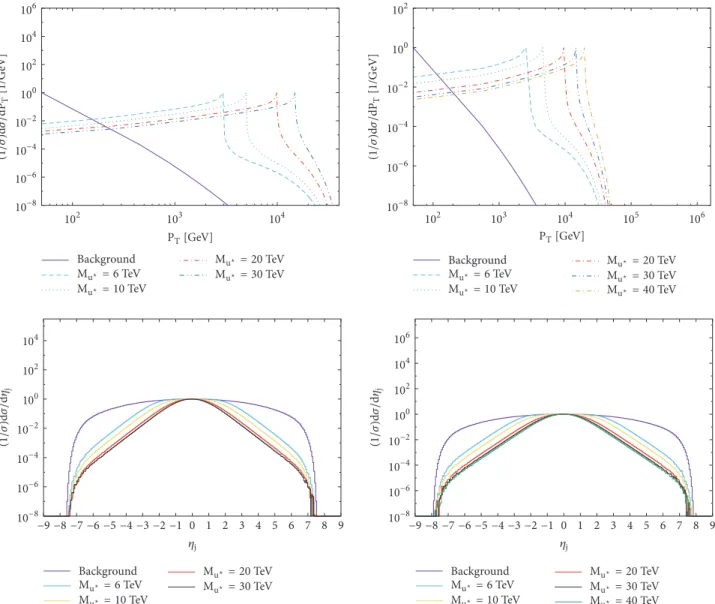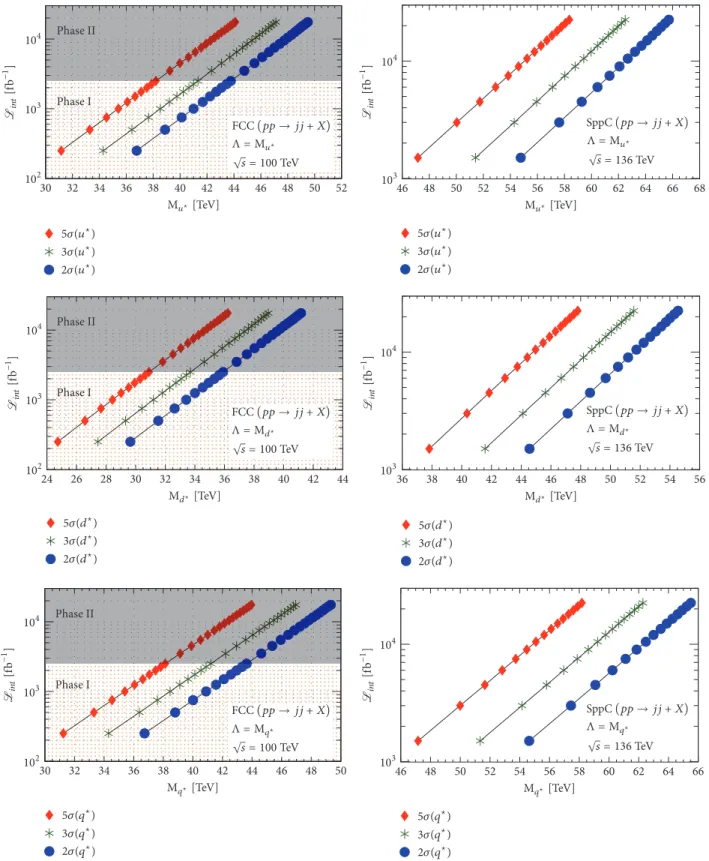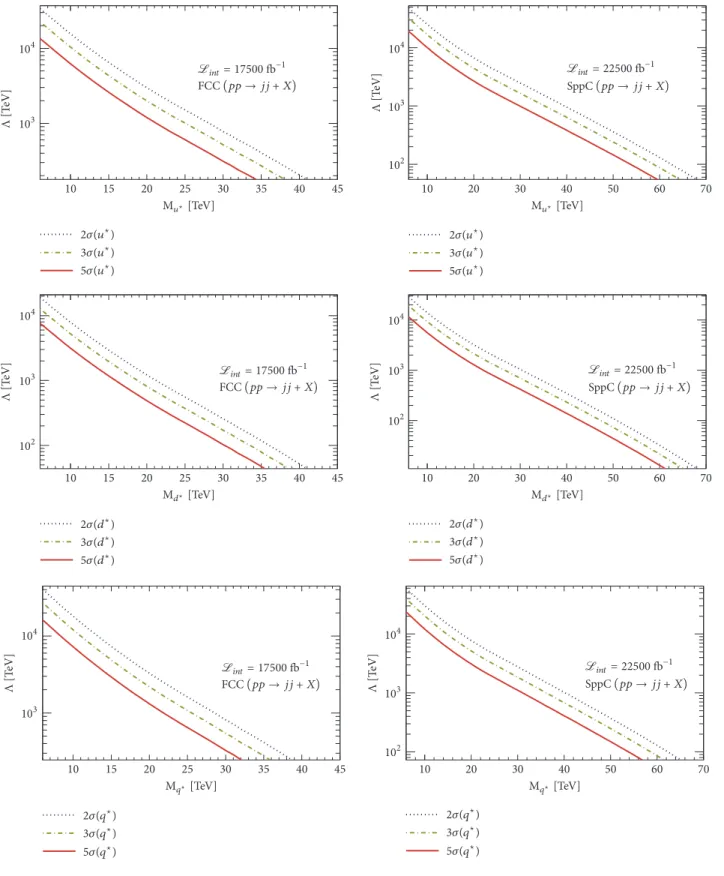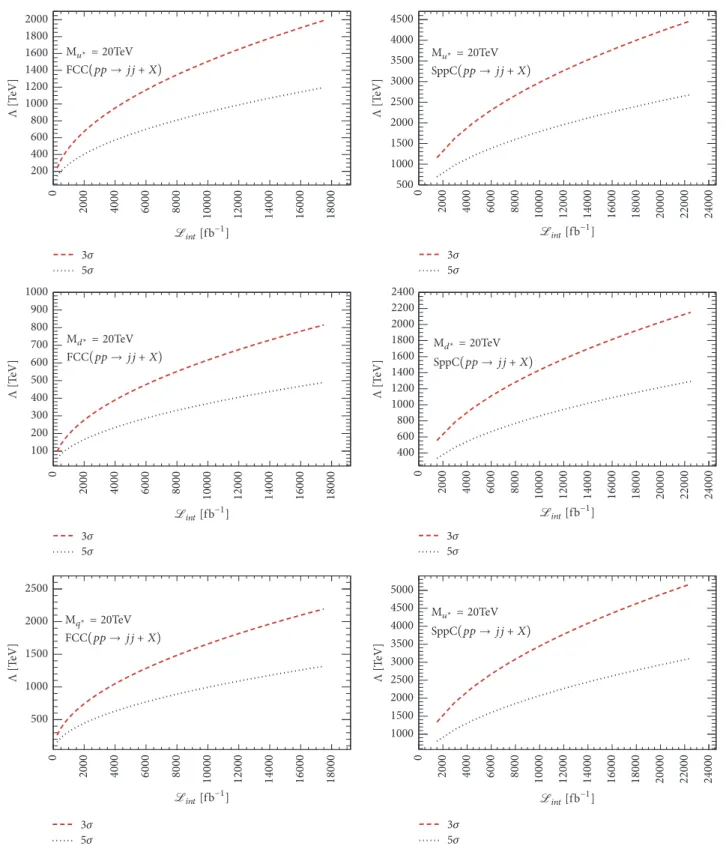Research Article
Search for Excited
𝑢 and 𝑑 Quarks in Dijet Final States at
Future
𝑝𝑝 Colliders
Ahmet Nuri Akay,
1Yusuf Oguzhan Günaydin
,
2Mehmet Sahin,
3and Saleh Sultansoy
1,41TOBB Economics and Technology University, Ankara, Turkey
2Department of Physics, Kahramanmaras S¨utc¨u Imam University, Kahramanmaras, Turkey 3Department of Physics, Usak University, Usak, Turkey
4ANAS, Institute of Physics, Baku, Azerbaijan
Correspondence should be addressed to Yusuf Oguzhan G¨unaydin; yusufgunaydin@gmail.com
Received 17 November 2018; Revised 19 February 2019; Accepted 25 February 2019; Published 17 March 2019 Academic Editor: Theocharis Kosmas
Copyright © 2019 Ahmet Nuri Akay et al. This is an open access article distributed under the Creative Commons Attribution License, which permits unrestricted use, distribution, and reproduction in any medium, provided the original work is properly cited. The publication of this article was funded by SCOAP3.
Resonant production of excited𝑢 and 𝑑 quarks at the Future Circular Collider and Super Proton-Proton Collider has been researched. Dominant jet-jet decay mode has been considered. It is shown that FCC and SppC have great potential for discovery of excited𝑢 (𝑑) quark: up to 44.1 (36.3) and 58.4 (47.8) TeV masses, respectively. For degenerate case (M𝑢⋆= M𝑑⋆), these values are
45.9 and 60.9 TeV, respectively. This discovery will also afford an opportunity to determine the compositeness scale up to multi-PeV level.
1. Introduction
Standard model (SM) contains plenty of elementary particles and their parameters that are not completely explained. To overcome these unsolved problems that the SM does not give answers, new models have been developed beyond the standard model (BSM) such as composite models, supersym-metry, extra dimensions, string theory, and so on. These BSM theories require higher energy level than SM energy domain to bring solutions for unanswered problems. Therefore, the SM is considered as low energy configuration of the more fundamental theory.
Numbers of particles and parameters in the SM are reduced in the frame of the composite models [1–16]. Accord-ing to composite models, while SM quarks and leptons are predicted as composite particles, preons are considered as the most fundamental particles. If excited states of the SM fermions are experimentally observed, this observation will be clear proof of quarks and leptons’ compositeness.
Excited fermions are known to represent much heavier particles than the SM fermions and they could be split into two classes: excited quarks (𝑞⋆) and excited leptons (𝑙⋆). These
heavy particles could also have spin-1/2 and spin-3/2 states. From the first publication on excited leptons in 1965 [17] until today, there have been plenty of phenomenological [18– 38] and experimental [39–53] studies performed on excited fermions.
Excited states of SM quarks might be shown in four possible final states with light jets,𝑞⋆ → 𝑗𝑗, 𝑞⋆ → 𝛾𝑗,
𝑞⋆ → 𝑊𝑗, and 𝑞⋆ → 𝑍𝑗. Currently, the LHC puts
experimental mass limits for all four final state cases [47, 51– 54] that are M𝑞⋆ = 6.0 (6.0), 5.5 (5.5), 3.2 (5.0), and 2.9
(4.7) TeV for ATLAS (CMS), respectively. Like SM fermions, excited fermions also have three families and we focused on 𝑢⋆and𝑑⋆productions which decay to dijet final states.
After the LHC physics mission is over, a new and more powerful collider will take place as an energy frontier discovery machine for the high energy physics. At CERN located in Geneva, Future Circular Collider (FCC) [55] is planned for the next step with √𝑠 = 100 TeV. The other project, Super Proton-Proton Collider (SppC), is planned in China at multi-TeV center of mass (CM) energies [56]; we chose √𝑠 = 136 TeV option in this study. Both projects
Volume 2019, Article ID 9090785, 11 pages https://doi.org/10.1155/2019/9090785
10 20 30 40 50 60 70 80 90 100 Γ [T eV ] 102 101 100 10−1 10−2 10−3 Γ [T eV ] 102 101 100 10−1 10−2 10−3 ->⋆[TeV] 10 20 30 40 50 60 70 80 90 100 -O⋆[TeV] Λ=->⋆ Λ=100 TeV Λ=-O⋆ Λ=100 TeV
Figure 1: Decay widths versus first generation excited quark masses for bothΛ = 𝑀𝑑⋆,Λ = 𝑀𝑢⋆, andΛ = 100 TeV.
Table 1: Planned operation time of FCC and SppC and their main parameters.
Collider Name FCC SppC
Phase I Phase II
Operation Time 10 Years 15 Years 15 Years
√𝑠 [TeV] 100 136
L𝑖𝑛𝑡[fb−1] 2500 15000 22500 17500
promise very high luminosity. The FCC will be expected to reach 2500𝑓𝑏−1integrated luminosity in ten years (Phase I) and 15000𝑓𝑏−1 integrated luminosity in 15 years (Phase II) [57–59]. Overall in 25 years, total integrated luminosity will be 17500𝑓𝑏−1. On the other hand, the SppC will deliver𝑝𝑝 collisions with 22500𝑓𝑏−1 integrated luminosity in 15 years (see Table 1).
In this research, we explore spin-1/2 excited𝑢 and 𝑑 quark (𝑢⋆ and𝑑⋆) decaying into dijet final states at the FCC and the SppC. In the following sections, we state spin-1/2 excited quark interaction Lagrangian, decay widths, and cross section values in Section 2, signal-background analysis to determine cuts in Section 3, and attainable mass and compositeness scale (Λ) limits and conclusions in Section 4.
2. Interaction Lagrangian, Decay Widths, and
Cross Sections
When left- and right-handed components of excited quarks are assigned to isodoublets, isospin structure of the first generation SM and excited quarks will be
[𝑢 𝑑]𝐿, 𝑢𝑅, 𝑑𝑅[ 𝑢⋆ 𝑑⋆]𝐿, [ 𝑢⋆ 𝑑⋆]𝑅. (1)
Since interaction Lagrangian is magnetic-moment type, it contains only left-handed quark doublet and consequently right-handed excited quark doublet. For that reason, as an effective interaction Lagrangian [20, 22, 25, 54], Equation (2) was utilized for the spin-1/2 excited quarks:
𝐿𝑒𝑓𝑓= 1 2Λ ⋅ 𝑞⋆ 𝑅𝜎𝜇][𝑔𝑠𝑓𝑠𝜆2𝑎𝐺𝜇]𝑎 + 𝑔𝑓 →𝜏 2 → 𝑊𝜇]+ 𝑔𝑓𝑌2𝐵𝜇]] 𝑞𝐿 + ℎ.𝑐. (2)
where compositeness scale is represented asΛ, 𝑞⋆𝑅 denotes right-handed excited quark doublet,𝑞𝐿depicts ground state left-handed quark doublet, and field strength tensors are 𝐺𝑎
𝜇] for gluon, →𝑊𝜇] for SU(2), and 𝐵𝜇] for U(1). 𝜆𝑎, →𝜏, and 𝑌 are color parameters for gluon-quark interaction, Pauli spin matrices, and weak hyper-charge, respectively. Gauge coupling constants are𝑔𝑠,𝑔, and 𝑔; and𝑓𝑠, 𝑓, 𝑓are free parameters that are taken as equal to 1 in numerical calculations. In addition, mentioned interactions with Higgs Boson as well as mass mixing among quarks and excited quarks can be neglected since M𝑢⋆ ≫ 𝜂 ≫ M𝑢(𝜂 is vacuum
expectation value of Higgs field). Indeed, M𝑢⋆ > 6 TeV from
the LHC data,𝜂 ≈ 245 GeV, and M𝑢is in MeV region. Interaction Lagrangian Equation (2) was implemented into CalcHEP [60] software by using LanHEP interface [61, 62]. In our calculations, CTEQ6L1 [63, 64] parton distribution function was used and factorizations and renor-malization scale were taken equal to𝑀𝑞⋆.
Partial decay widths of first generation excited quarks are listed in Table 2. Parameters in the last column of Table 2 are 𝑓𝑍= 𝑓𝑇3cos2𝜃𝑊− 𝑓(𝑌/2)sin2𝜃𝑊,𝑓𝑊= 𝑓/√2, 𝑓𝛾= 𝑓𝑇3+ 𝑓𝑌/2, 𝑔
𝑊 = √4𝜋𝛼/ sin 𝜃𝑊, and𝑔𝑍 = 𝑔𝑊/ cos 𝜃𝑊; here𝑇3 is the third component of the weak isospin of𝑞⋆. In Figure 1,
Table 2: Third component of isospins, charges, decay channels, and widths of up- and down-type excited quarks.
T3 Q Decay Modes Partial Decay Widths
1 2 23 𝑢⋆→ 𝑑𝑊+ Γ = 1 32𝜋𝑔2𝑊𝑓𝑊2 𝑀3 𝑢⋆ Λ2 (1 − 𝑚2 𝑊 𝑀2 𝑢⋆) 2 (2 + 𝑚2𝑊 𝑀2 𝑢⋆) 𝑢⋆→ 𝑢𝑍 Γ = 1 32𝜋𝑔𝑍2𝑓𝑍2 𝑀3 𝑢⋆ Λ2 (1 − 𝑚2 𝑍 𝑀2 𝑢⋆) 2 (2 + 𝑚2𝑍 𝑀2 𝑢⋆) 𝑢⋆→ 𝑢𝑔 Γ = 1 3𝛼𝑠𝑓𝑠2 𝑀3 𝑢⋆ Λ2 𝑢⋆→ 𝑢𝛾 Γ = 1 4𝛼𝑓𝛾2 𝑀3 𝑢⋆ Λ2 −1 2 −13 𝑑⋆→ 𝑢𝑊− Γ = 1 32𝜋𝑔2𝑊𝑓𝑊2 𝑀3 𝑑⋆ Λ2 (1 − 𝑚2 𝑊 𝑀2 𝑑⋆) 2 (2 + 𝑚2𝑊 𝑀2 𝑑⋆) 𝑑⋆→ 𝑑𝑍 Γ = 1 32𝜋𝑔𝑍2𝑓𝑍2 𝑀3 𝑑⋆ Λ2 (1 − 𝑚2 𝑍 𝑀2 𝑑⋆) 2 (2 + 𝑚2𝑍 𝑀2 𝑑⋆) 𝑑⋆→ 𝑑𝑔 Γ = 1 3𝛼𝑠𝑓𝑠2 𝑀3 𝑑⋆ Λ2 𝑑⋆→ 𝑑𝛾 Γ = 1 4𝛼𝑓𝛾2 𝑀3 𝑑⋆ Λ2 u⋆ g g u u u u⋆ g g u u⋆ g g u u u⋆ g g u u u⋆ g g u u u⋆ g g u u
Figure 2: Feynman diagrams for direct (first column) and indirect production of𝑢⋆at𝑝𝑝 colliders.
total decay widths are given forΛ = 𝑀𝑑⋆,Λ = 𝑀𝑢⋆, andΛ =
100 TeV by scanning excited quarks mass from 6 TeV to 100 TeV. Total decay widths of𝑢⋆and𝑑⋆are close to each other since dominant decay modes are𝑢⋆ → 𝑔𝑢 and 𝑑⋆ → 𝑔𝑑. There are small differences caused by𝑍 and 𝛾 channels. It is obviously seen that while𝑑⋆ and𝑢⋆ mass values are risen, decay widths are increased.
For the following parts of this study, we consider three cases to do analysis: (a)𝑀𝑢⋆ < 𝑀𝑑⋆, (b)𝑀𝑑⋆ < 𝑀𝑢⋆, and
(c)𝑀𝑢⋆ = 𝑀𝑑⋆(degenerate state) with𝑝𝑝 → 𝑢⋆ + 𝑋 →
𝑢𝑔 + 𝑋, 𝑝𝑝 → 𝑑⋆ + 𝑋 → 𝑑𝑔 + 𝑋, and 𝑝𝑝 → 𝑞⋆ +
𝑋 → 𝑞𝑔 + 𝑋 signal processes, respectively (here, 𝑞⋆denotes 𝑢⋆+ 𝑑⋆). 6 Feynman diagrams emerge for cases (a) and (b), and 12 Feynman diagrams make contributions to signal cross
section calculations for the case (c). Figure 2 presents the case (a) Feynman diagrams for illustration. Analytical expression for the cross sections at parton level corresponding to these diagrams is described by Equation (3):
𝑑̂𝜎 𝑑̂𝑡 = 𝑓𝑠4𝑔4𝑠 216𝜋Λ4(𝑀2 𝑢⋆− ̂𝑠)2 [−48𝑀𝑢8⋆+ 68𝑀6𝑢⋆̂𝑠+ 11𝑀𝑢4⋆̂𝑠2− 34𝑀2𝑢⋆̂𝑠3+ 6̂𝑠4 (𝑀2 𝑢⋆− ̂𝑠)2 +−8𝑀8𝑢⋆− 11𝑀𝑢6⋆̂𝑠 (𝑀2 𝑢⋆− ̂𝑡)2 +32𝑀𝑢6⋆+ 33𝑀𝑢4⋆̂𝑠 𝑀2 𝑢⋆− ̂𝑡 − 16̂𝑠̂𝑡 − 16̂𝑡2+−8𝑀8𝑢⋆− 11𝑀𝑢6⋆̂𝑠 (𝑀2 𝑢⋆+ ̂𝑠+ ̂𝑡)2 +32𝑀𝑢6⋆+ 33𝑀4𝑢⋆̂𝑠 𝑀2 𝑢⋆+ ̂𝑠+ ̂𝑡 ] (3)
SppC (Λ = -u⋆) FCC (Λ = -u⋆) SppC (Λ = 100 TeV) FCC (Λ = 100 TeV) SppC (Λ = -d⋆) FCC (Λ = -d⋆) SppC (Λ = 100 TeV) FCC (Λ = 100 TeV) SppC (Λ = -q⋆) FCC (Λ = -q⋆) SppC (Λ = 100 TeV) FCC (Λ = 100 TeV) 102 10 -u⋆[TeV] 10−7 10−6 10−5 10−4 10−3 10−2 10−1 1 10 102 [p b] 10−7 10−6 10−5 10−4 10−3 10−2 10−1 1 10 102 [p b] 102 10 -d⋆[TeV] 10−7 10−6 10−5 10−4 10−3 10−2 10−1 1 10 102 [pb] 102 10 -q⋆[TeV]
Figure 3: Cross section values of the first generation𝑢⋆,𝑑⋆, and𝑞⋆(degenerate state) excited quarks at the FCC and SppC.
In Figure 3, first generation excited quarks cross section values for three cases mentioned above are plotted for the FCC (√𝑠 = 100 TeV) and the SppC (√𝑠 = 136 TeV) with Λ = 𝑀𝑢⋆,Λ = 𝑀𝑑⋆,Λ = 𝑀𝑞⋆(degenerate state), andΛ = 100
TeV. When the compositeness scale value is taken as equal to excited quark masses, cross section values are about 300 times higher at 6 TeV mass value for both collider options. Indeed, it seems that excited quark could be produced at very high mass values for both collider options. It should be noted that as the LHC experimental studies on excited quarks with dijet final states do not consider SM interference contribution to cross section [47, 51], we did not simulate interference with SM for the FCC and SppC at this stage. For the same reason, QCD corrections were disregarded in this analysis [47, 52, 65–67].
3. Signal and Background Analysis
Signal processes were defined in previous section. Back-ground process which is used in calculation is𝑝𝑝 → 𝑗𝑗 + 𝑋;
here𝑗 denotes 𝑢, 𝑢, 𝑑, 𝑑, 𝑐, 𝑐, 𝑠, 𝑠, 𝑏, 𝑏 and 𝑔 for three signal cases. It is important to determine transverse momentum (𝑃𝑇), pseudo rapidity (𝜂), and invariant mass (𝑀𝑗𝑗) cut values for selecting clear signal. To illustrate cut selection, only final state particles distribution originated by excited𝑢 quark plots are included in Figure 4. According to these figures,𝑃𝑇cuts are applied as 2 TeV, and𝜂 cuts are determined as |𝜂| < 2.5 in signal and background cross section calculations for three cases. Also, the cone angle radius is chosen asΔ𝑅 > 0.5 for both colliders. Additionally, invariant mass cuts are applied as𝑀⋆− 2Γ⋆ < 𝑀𝑗𝑗< 𝑀⋆+ 2Γ⋆mass window for again both collider options; here𝑀⋆denotes excited quarks (𝑢⋆,𝑑⋆, and 𝑞⋆) mass andΓ⋆is total decay widths of the excited quarks.
In order to calculate statistical significance, Equation (4) is used:
𝑆𝑆 = 𝜎𝑆
04[GeV] 04[GeV] 102 103 104 105 106 102 103 104 -O⋆= 6 TeV -O⋆= 10 TeV Background -O⋆ = 20 TeV -O⋆ = 30 TeV -O⋆ = 20 TeV -O⋆ = 30 TeV -O⋆ = 40 TeV -O⋆ = 6 TeV -O⋆ = 10 TeV Background -O⋆ = 6 TeV -O⋆ = 10 TeV Background -O⋆ = 20 TeV -O⋆ = 30 TeV -O⋆= 6 TeV -O⋆= 10 TeV Background -O⋆ = 20 TeV -O⋆ = 30 TeV -O⋆ = 40 TeV 7 6 5 4 3 2 1 0 8 9 −2 −3 −4 −5 −6 −7 −8 −1 −9 D 10−8 10−6 10−4 10−2 100 102 104 106 (1/)>/> D 7 6 5 4 3 2 1 0 8 9 −2 −3 −4 −5 −6 −7 −8 −1 −9 D 10−8 10−6 10−4 10−2 100 102 104 (1/)>/> D 10−8 10−6 10−4 10−2 100 102 104 106 (1/)>/>0 4 [1/G eV] 10−8 10−6 10−4 10−2 100 102 (1/)>/>0 4 [1/G eV]
Figure 4: Transverse momentum and𝜂 distribution plots for FCC (left column) and SppC (right column).
where 𝜎𝑆 and 𝜎𝐵 denote signal and background cross section values, respectively, and L𝑖𝑛𝑡 represents integrated luminosity. Using Equation (4), we have calculated excited quarks mass’ discovery (5𝜎), observation (3𝜎), and exclusion (2𝜎) limits on prospective frontier machines, namely, FCC and SppC.
4. Results and Conclusions
Discovery, observation, and exclusion limits on the mass of excited quarks for three cases depending on integrated
luminosity of the FCC and SppC withΛ = 𝑀⋆ cases are
plotted in Figure 5. Attainable mass limits for all three cases for FCC-Phases I and II and SppC with their final integrated luminosity values at the end of operating times are listed in Table 3. It is seen that FCC-Phase I will afford an opportunity to discover, observe, or exclude degenerate case of excited
quarks up to 40.1, 43.2, and 45.6 TeV, respectively. At the end of the FCC-Phase II, these values become𝑀𝑞⋆ = 45.9 TeV
(5𝜎), 𝑀𝑞⋆= 48.9 TeV (3𝜎), and 𝑀𝑞⋆= 51.3 TeV (2𝜎). On the
other hand, corresponding values for SppC are𝑀𝑞⋆ = 60.9
TeV (5𝜎), 𝑀𝑞⋆ = 65.0 TeV (3𝜎), and 𝑀𝑞⋆ = 68.1 TeV (2𝜎)
that essentially exceed the FCC limits.
As mentioned above, we did not anticipate interference of the signal model with the SM contribution. In order to estimate this contribution, we compared discovery limits for 𝑢⋆ at the FCC-Phase II. As seen from Table 3, this limit was 44.1 TeV in our case. If one takes interference terms into account, discovery limit becomes 45.0 TeV. The latter value was obtained using same discovery cuts together with corresponding statistical signification equation, namely,
𝑆𝑆 = 𝜎𝑡𝑜𝑡− 𝜎𝐵
s = 136 TeV SppC(pp → jj + X) Λ = -u⋆ s = 136 TeV SppC(pp → jj + X) Λ = -d⋆ s = 136 TeV Λ = -q⋆ SppC(pp → jj + X) s = 100 TeV Λ = -d⋆ FCC(pp → jj + X) s = 100 TeV Λ = -q⋆ FCC(pp → jj + X) s = 100 TeV FCC(pp → jj + X) Λ = -u⋆ Phase I Phase II Phase I Phase II Phase I Phase II 103 102 104 103 102 104 103 102 104 103 104 103 104 103 104 ℒint [@ < −1 ] ℒ int [@ < −1] ℒint [@ < −1 ] ℒint [@ < −1 ] ℒint [@ < −1] ℒ int [@ < −1 ] 5(u⋆) 3(u⋆) 2(u⋆) 5(u⋆) 3(u⋆) 2(u⋆) 5(d⋆) 3(d⋆) 2(d⋆) 5(d⋆) 3(d⋆) 2(d⋆) 5(q⋆) 3(q⋆) 2(q⋆) 5(q⋆) 3(q⋆) 2(q⋆) 48 50 52 54 56 58 60 62 64 66 68 46 -u⋆[TeV] 38 40 42 44 46 48 50 52 54 56 36 -d⋆[TeV] 48 50 52 54 56 58 60 62 64 66 46 -q⋆[TeV] 32 34 36 38 40 42 44 46 48 50 30 -q⋆[TeV] 26 28 30 32 34 36 38 40 42 44 24 -d⋆[TeV] 32 34 36 38 40 42 44 46 48 50 52 30 -u⋆[TeV]
Table 3: Attainable mass limits for all three cases at FCC and SppC with corresponding final integrated luminosity values. Compositeness scale is chosen equal to excited quarks mass values.
Colliders FCC-Phase I FCC-Phase II SppC
Integrated Luminosity [fb−1] 2500 17500 22500
Significance 5𝜎 3𝜎 2𝜎 5𝜎 3𝜎 2𝜎 5𝜎 3𝜎 2𝜎
Excited Quark Mass [TeV]
M𝑢⋆ 38.2 41.3 43.8 44.1 47.1 49.5 58.4 62.5 65.7 M𝑑⋆ 30.9 33.7 35.9 36.3 39.0 41.2 47.8 51.6 54.5 M𝑞⋆ 40.1 43.2 45.6 45.9 48.9 51.3 60.9 65.0 68.1
Table 4: Compositeness scale values corresponding to some selected mass quantities for all three cases at FCC with final integrated luminosity values.
FCC (L𝑖𝑛𝑡=17500 fb−1)
Mass [TeV]
Compositeness ScaleΛ [PeV]
𝑢⋆ 𝑑⋆ 𝑞⋆ 5𝜎 3𝜎 2𝜎 5𝜎 3𝜎 2𝜎 5𝜎 3𝜎 2𝜎 6 13.5 22.4 33.6 7.61 12.7 19.0 19.4 32.3 48.5 10 6.21 10.4 15.5 3.15 5.25 7.88 9.22 15.4 23.1 20 1.20 1.99 2.99 .489 .815 1.22 1.78 2.97 4.46 30 .311 .518 .776 .102 .171 .256 .448 .747 1.12
Table 5: Compositeness scale values corresponding to some selected mass quantities for all three cases at SppC with final integrated luminosity values.
SppC (L𝑖𝑛𝑡=22500 fb−1) Mass [TeV]
Compositeness ScaleΛ [PeV]
𝑢⋆ 𝑑⋆ 𝑞⋆ 5𝜎 3𝜎 2𝜎 5𝜎 3𝜎 2𝜎 5𝜎 3𝜎 2𝜎 6 19.2 32.0 48.0 11.5 19.2 28.8 28.6 47.6 71.4 10 10.1 16.8 25.2 5.59 9.31 14.0 15.4 25.7 38.5 20 2.68 4.47 6.71 1.29 2.15 3.23 4.16 6.94 10.4 30 .993 1.66 2.48 .418 .696 1.04 1.51 2.52 3.78 40 .383 .638 .957 .139 .231 .347 .562 .936 1.41
where𝜎𝑡𝑜𝑡 includes signal, SM, and interference contri-butions. Interference terms lead to slightly higher discovery limit. Therefore, presented results in this study can be considered as a bit conservative.
Concerning the role of systematic uncertainties caused by choice of PDF, factorization and renormalization scales, analysis performed at the ATLAS and CMS experiments show that their impact is less than 1% for𝑞⋆→ 𝑗𝑗 channel [47]. As for the efficiency of jet registration, it is nearly 100% for jets with𝑃𝑇above 20 GeV [47].
In principle, compositeness scale might be quite higher than excited quark mass. If excited𝑢 and 𝑑 quarks are not discovered at FCC or SppC, one can evaluate lower limits on compositeness scale. For illustration, we plot achievable compositeness scale depending on𝑢⋆, 𝑑⋆, and𝑞⋆ mass for ultimate luminosity values at both colliders in Figure 6. If it is
assumed that𝑢⋆mass equals 20 TeV and it is not seen at FCC in resonant channel, according to Figure 6, this means that compositeness scale is larger than 1.2 PeV (5𝜎), 2.0 PeV (3𝜎), and 3.0 PeV (2𝜎). Achievable scales for other values of 𝑢⋆as well as𝑑⋆and𝑞⋆(degenerate state) are presented in Table 4. Similar results for the SppC are given in Table 5.
In Figure 7, necessary luminosities for observation and discovery of 20 TeV mass excited u quark depending on compositeness scale are plotted for both energy-frontier
colliders. It is seen that if Λ = 1000 TeV, FCC will
observe𝑢⋆with4500 𝑓𝑏−1integrated luminosity andL𝑖𝑛𝑡= 12000 𝑓𝑏−1is needed for discovery, which correspond to 12 and 19.5 operation years, respectively. Concerning the SppC, it will observe 𝑢⋆ with 20 TeV mass within first year and discover it in 2 years if compositeness scale is equal to 1000 TeV.
103 104 103 102 104 103 104 103 102 104 103 102 104 103 102 104 ℒint= 22500 f<−1 SppC(pp → jj + X) 5(q⋆) 5(q⋆) 2(q⋆) 3(q⋆) FCC(pp → jj + X) ℒint= 17500 f<−1 ℒint= 22500 f<−1 SppC(pp → jj + X) 2(d⋆) 3(d⋆) 5(d⋆) 2(d⋆) 3(d⋆) 5(d⋆) FCC(pp → jj + X) ℒint= 17500 f<−1 2(u⋆) 3(u⋆) 5(u⋆) ℒint= 22500 f<−1 SppC(pp → jj + X) 2(u⋆) 3(u⋆) 5(u⋆) FCC(pp → jj + X) ℒint= 17500 f<−1 Λ [T eV] Λ [T eV] Λ [T eV] Λ [T eV] Λ [T eV] Λ [T eV] 15 20 25 30 35 40 45 10 -u⋆[TeV] 15 20 25 30 35 40 45 10 -d⋆[TeV] 15 20 25 30 35 40 45 10 -q⋆[TeV] 20 30 40 50 60 70 10 -q⋆[TeV] 20 30 40 50 60 70 10 -d⋆[TeV] 20 30 40 50 60 70 10 -u⋆[TeV] 2(q⋆) 3(q⋆)
Figure 6: Compositeness scale dependence on𝑢⋆mass for the FCC (left column) and SppC (right column).
In conclusion, FCC and SppC have excellent potential for discovery of excited 𝑢 and 𝑑 quarks. If compositeness scale coincides with excited quark masses, FCC reaches M𝑢⋆
= 44 TeV, M𝑑⋆ = 36 TeV, and M𝑞⋆ = 46 TeV (degenerate
state). Corresponding values for SppC are 58 TeV, 48 TeV, and 61 TeV, respectively. If compositeness scale is higher than excited quark masses, discovery of excited quarks will afford an opportunity to determineΛ at the same time.
0 2000 4000 6000 8000 10000 12000 14000 16000 18000 20000 22000 24000 500 1000 1500 2000 2500 3000 3500 4000 4500 0 2000 4000 6000 8000 10000 12000 14000 16000 18000 20000 22000 24000 400 600 800 1000 1200 1400 1600 1800 2000 2200 2400 0 2000 4000 6000 8000 10000 12000 14000 16000 18000 20000 22000 24000 ℒint[@<−1] ℒint[@<−1] ℒint[@<−1] Λ [T eV] Λ [T eV] 3 5 3 5 3 5 3 5 3 5 3 5 -u⋆= 20TeV FCC(pp → jj + X) FCC(pp → jj + X) = 20TeV -d⋆ = 20TeV -q⋆ FCC(pp → jj + X) -u⋆ = 20TeV SppC(pp → jj + X) SppC(pp → jj + X) = 20TeV -d⋆ SppC(pp → jj + X) 200 400 600 800 1000 1200 1400 1600 1800 2000 Λ [T eV] 0 8000 6000 4000 2000 10000 12000 14000 16000 18000 ℒint[@<−1] 0 2000 4000 6000 8000 10000 12000 14000 16000 18000 ℒint[@<−1] 100 200 300 400 500 600 700 800 900 1000 Λ [T eV] 500 1000 1500 2000 2500 Λ [T eV] 0 2000 4000 6000 8000 10000 12000 14000 16000 18000 ℒint[@<−1] 1000 1500 2000 2500 3000 3500 4000 4500 5000 Λ [T eV] -u⋆ = 20TeV
Figure 7: Compositeness scale-luminosity correlation plots for the FCC (left column) and SppC (right column).
Data Availability
No data were used to support this study.
Conflicts of Interest
The authors declare that they have no conflicts of interest.
Acknowledgments
This study is supported by TUBITAK under the grant No. [114F337]. Authors are grateful to the Usak University, Energy, Environment and Sustainability Application and Research Center for their support.
References
[1] J. C. Pati and A. Salam, “Erratum: Lepton number as the fourth ’color’,” Physical Review D: Particles, Fields, Gravitation and
Cosmology, vol. 10, pp. 275–289, 1975.
[2] H. Terazawa, Y. Chikashige, and K. Akama, “Unified model of the Nambu-Jona-Lasinio type for all elementary-particle forces,” Physical Review D: Particles, Fields, Gravitation and
Cosmology, vol. 15, no. 2, pp. 480–487, 1977.
[3] M. A. Shupe, “A composite model of leptons and quarks,” Physics
Letters B, vol. 86, no. 1, pp. 87–92, 1979.
[4] H. Harari, “A schematic model of quarks and leptons,” Physics
Letters B, vol. 86, no. 1, pp. 83–86, 1979.
[5] H. Terazawa, “Subquark model of leptons and quarks,” Physical
Review D: Particles, Fields, Gravitation and Cosmology, vol. 22,
no. 1, pp. 184–199, 1980.
[6] H. Fritzsch and G. Mandelbaum, “Weak interactions as man-ifestations of the substructure of leptons and quarks,” Physics
Letters B, vol. 102, no. 5, pp. 319–322, 1981.
[7] H. Terezawa, M. Yasu`e, K. Akama, and M. Hayashi, “Observable effects of the possible sub-structure of leptons and quarks,”
Physics Letters B, vol. 112, no. 4-5, pp. 387–392, 1982.
[8] H. Terazawa, “A fundamental theory of composite particles and fields,” Physics Letters B, vol. 133, no. 1-2, pp. 57–60, 1983. [9] E. J. Eichten, K. D. Lane, and M. E. Peskin, “New tests for quark
and lepton substructure,” Physical Review Letters, vol. 50, no. 11, pp. 811–814, 1983.
[10] I. A. D’Souza and C. S. Kalman, Preons: Models of Leptons,
Quarks and Gauge Bosons as Composite Objects, 1992.
[11] A. C¸ elikel, M. Kantar, and S. Sultansoy, “A search for sextet quarks and leptogluons at the LHC,” Physics Letters B, vol. 443, no. 1-4, pp. 359–364, 1998.
[12] M. E. De Souza, “Weak decays of hadrons reveal compositeness of quarks,” Scientia Plena, vol. 4, no. 6, 2008.
[13] H. Terazawa and M. Yasu`e, “Composite higgs boson in the unified subquark model of all fundamental particles and forces,”
Journal of Modern Physics, vol. 05, no. 05, pp. 205–208, 2014.
[14] H. Terazawa and M. Yasue, “Excited gauge and higgs bosons in the unified composite model,” Nonlinear Phenomena in
Complex Systems, vol. 19, no. 1, pp. 1–6, 2016.
[15] H. Fritzsch, “Composite weak bosons at the large hadronic collider,” Modern Physics Letters A, vol. 31, no. 20, Article ID 1630019, 2016.
[16] U. Kaya, B. B. Oner, and S. Sultanoy, “A minimal fermion-scalar preonic model,” Turkish Journal of Physics, vol. 42, no. 3, pp. 235–241, 2018.
[17] F. E. Low, “Heavy electrons and muons,” Physical Review Letters, vol. 14, pp. 238-239, 1965.
[18] F. M. Renard, “Excited quarks and new hadronic states,” Il
Nuovo Cimento A (1965-1970), vol. 77, no. 1, pp. 1–20, 1983.
[19] L. Lyons, “An introduction to the possible substructure of quarks and leptons,” Progress in Particle and Nuclear Physics, vol. 10, pp. 227–304, 1983.
[20] J. K¨uhn and P. M. Zerwas, “Excited quarks and leptons,” Physics
Letters B, vol. 147, no. 1–3, pp. 189–196, 1984.
[21] G. Pancheri and Y. N. Srivastava, “Weak isospin spectroscopy of excited quarks and leptons,” Physics Letters B, vol. 146, no. 1-2, pp. 87–94, 1984.
[22] A. de R´ujula, L. Maiani, and R. Petronzio, “Search for excited quarks,” Physics Letters B, vol. 140, no. 3-4, pp. 253–258, 1984.
[23] K. Hagiwara, S. Komamiya, and D. Zeppenfeld, “Excited lepton production at LEP and HERA,” Zeitschrift f¨ur Physik C Particles
and Fields, vol. 29, no. 1, pp. 115–122, 1985.
[24] J. H. K¨uhn, H. D. Tholl, and P. M. Zerwas, “Signals of excited quarks and leptons,” Physics Letters B, vol. 158, no. 3, pp. 270– 275, 1985.
[25] U. Baur, I. Hinchliffe, and D. Zeppenfeld, “Excited quark pro-duction at Hadron colliders,” International Journal of Modern
Physics A, vol. 2, no. 4, pp. 1285–1297, 1987.
[26] M. Spira and P. Zerwas, “Excited quarks and leptons,” in Heavy
Flavours and High-Energy Collisions in the 1–100 TeV Range, pp.
519–529, Springer, 1989.
[27] U. Baur, M. Spira, and P. M. Zerwas, “Excited-quark and -lepton production at hadron colliders,” Physical Review D: Particles,
Fields, Gravitation and Cosmology, vol. 42, no. 3, pp. 815–824,
1990.
[28] G. Jikia, “Excited quark production at ep and𝛾p colliders,”
Nuclear Physics B, vol. 333, no. 2, pp. 317–334, 1990.
[29] F. Boudjema, A. Djouadi, and J. L. Kneur, “Excited fermions at e+e−and ep colliders,” Zeitschrift f¨ur Physik C Particles and
Fields, vol. 57, no. 3, pp. 425–449, 1993.
[30] O. C¸ akır and R. Mehdiyev, “Excited quark production at the CERN LHC,” Physical Review D: Particles, Fields, Gravitation
and Cosmology, vol. 60, no. 3, Article ID 034004, 1999.
[31] O. C¸ akır, C. Leroy, and R. Mehdiyev, “Search for excited quarks with the ATLAS experiment at the CERN LHC: Double jets channel,” Physical Review D: Particles, Fields, Gravitation and
Cosmology, vol. 62, no. 11, Article ID 114018, 2000.
[32] O. C¸ akır, C. Leroy, and R. Mehdiyev, “Search for excited quarks with the ATLAS experiment at the CERN LHC: W/Z+jet channel,” Physical Review D: Particles, Fields, Gravitation and
Cosmology, vol. 63, no. 9, Article ID 094014, 2001.
[33] O. J. P. ´Eboli, S. M. Lietti, and P. Mathews, “Excited leptons at the CERN large Hadron collider,” Physical Review D: Particles,
Fields, Gravitation and Cosmology, vol. 65, no. 7, Article ID
075003, 2002.
[34] O. C¸ akır, A. Yılmaz, and S. Sultansoy, “Single production of excited electrons at future e+e−, ep and pp colliders,” Physical
Review D: Particles, Fields, Gravitation and Cosmology, vol. 70,
no. 7, Article ID 075011, 2004.
[35] O. C¸ akır, C. Leroy, R. Mehdiyev, and A. Belyaev, “Production and decay of excited electrons at the LHC,” The European
Physical Journal C - Particles and Fields, vol. 32, supplement 2,
pp. s1–s17, 2004.
[36] O. C¸ akır and A. Ozansoy, “Search for excited spin-3/2 and spin-1/2 leptons at linear colliders,” Physical Review D: Particles,
Fields, Gravitation and Cosmology, vol. 77, no. 3, Article ID
035002, 2008.
[37] A. Caliskan, S. O. Kara, and A. Ozansoy, “Excited muon searches at the FCC-based muon-hadron colliders,” Advances in High
Energy Physics, vol. 2017, Article ID 1540243, 9 pages, 2017.
[38] A. Caliskan, “Excited neutrino search potential of the FCC-based electron-hadron colliders,” Advances in High Energy
Physics, vol. 2017, Article ID 4726050, 9 pages, 2017.
[39] F. Abe, M. G. Albrow, S. R. Amendolia et al., “Search for new particles decaying to dijets in pp collisions at√s = 1.8 TeV,”
Physical Review Letters, vol. 74, no. 18, pp. 3538–3543, 1995.
[40] The H1 Collaboration, C. Adloff et al., “A search for excited fermions at HERA,” The European Physical Journal C - Particles
[41] L3 Collaboration, M. Acciarri et al., “Search for excited leptons in e+e− interactions at s=192–202 GeV,” Physics Letters B, vol. 502, no. 1-4, pp. 37–50, 2001.
[42] ZEUS Collaboration, S. Chekanov et al., “Searches for excited fermions in ep collisions at HERA,” Physics Letters B, vol. 549, no. 1-2, pp. 32–47, 2002.
[43] J. Abdallah, DELPHI Collaboration et al., “Search for excited leptons in e+e−collisions at√s =189–209 GeV,” The European
Physical Journal C - Particles and Fields, vol. 46, p. 277, 2006.
[44] CMS Collaboration, V. Khachatryan et al., “Search for excited quarks in the𝛾 + jet final state in proton-proton collisions at √s = 8TeV,” Physics Letters B, vol. 738, pp. 274–293, 2014.
[45] G. Aad, ATLAS collaboration et al., “Search for new phenomena with photon+jet events in proton-proton collisions at√s = 13 TeV with the ATLAS detector,” Journal of High Energy Physics, vol. 2016, no. 3, p. 41, 2016.
[46] G. Aad, ATLAS collaboration et al., “Search for new phenomena in dijet mass and angular distributions from pp collisions at√s = 13 TeV with the ATLAS detector,” Physics Letters B, vol. 754, pp. 302–322, 2016.
[47] M. Aaboud, ATLAS Collaboration et al., “Search for new phenomena in dijet events using 37 fb−1of pp collision data collected at√s = 13 TeV with the ATLAS detector,” Physical
Review D, vol. 96, Article ID 052004, 2017.
[48] V. Khachatryan, CMS Collaboration et al., “Search for narrow resonances decaying to dijets in proton-proton collisions at√s = 13 TeV,” Physical Review Letters, vol. 116, Article ID 071801, 2016.
[49] CMS Authors, “Search for excited quarks in the photon + jet final state in proton proton collisions at 13 TeV,” CMS-PAS-EXO-16-015, CERN, Geneva, Switzerland, 2016.
[50] CMS Collaboration, A. M. Sirunyan et al., “Search for dijet resonances in proton proton collisions at √s = 13 TeV and constraints on dark matter and other models,” Physics Letters
B, vol. 769, Article ID S0370269317301028, pp. 520–542, 2017.
[51] CMS Collaboration, A. M. Sirunyan et al., “Search for narrow and broad dijet resonances in proton-proton collisions at√s =13 TeV and constraints on dark matter mediators and other new particles,” Journal of High Energy Physics, vol. 2018, p. 130, 2018. [52] CMS Collaboration, A. M. Sirunyan et al., “Search for excited quarks of light and heavy flavor in 𝛾+jet final states in proton–proton collisions at√s = 13 TeV,” Physics Letters B, vol. 781, pp. 390–411, 2018.
[53] CMS Collaboration, A. M. Sirunyan et al., “Search for massive resonances decaying into WW, WZ, ZZ, qW, and qZ with dijet final states at√s = 13 TeV,” Physical Review D, vol. 97, Article ID 072006, 2018.
[54] C. Patrignani, Particle Data Group et al., “Review of particle physics,” Chinese Physics C, vol. C40, no. 10, Article ID 100001, 2016.
[55] “Future circular collider study kickoff meeting,” University of Geneva, February 2014. http://indico.cern.ch/e/fcc-kickoff. [56] F. Su, J. Gao, M. Xiao et al., “Method study of parameter choice
for a circular proton-proton collider,” Chinese Physics C, vol. 40, no. 1, Article ID 017001, 2016.
[57] M. Benedikt, D. Schulte, and F. Zimmermann, “Optimizing integrated luminosity of future hadron colliders,” Physical
Review Special Topics - Accelerators and Beams, vol. 18, no. 10,
Article ID 101002, 2015.
[58] M. Benedikt, F. Zimmermann, M. Syphers, B. Goddard, and D. Schulte, “Fcc-hh hadron collider-parameter scenarios and staging options,” Tech. Rep. IPAC2015, 2015.
[59] M. Benedikt and F. Zimmermann, “Towards future circular colliders,” Journal of the Korean Physical Society, vol. 69, no. 6, pp. 893–902, 2016.
[60] A. Belyaev, N. D. Christensen, and A. Pukhov, “CalcHEP 3.4 for collider physics within and beyond the standard model,”
Computer Physics Communications, vol. 184, no. 7, pp. 1729–
1769, 2013.
[61] A. V. Semenov, “LanHEP: A Package for automatic generation of Feynman rules in field theory. Version 2.0,” 2002.
[62] A. Semenov, “LanHEP - A package for automatic generation of Feynman rules from the Lagrangian. Version 3.2,” Computer
Physics Communications, vol. 201, pp. 167–170, 2016.
[63] J. Pumplin, D. Robert Stump, J. Huston, H.-L. Lai, P. Nadolsky, and W.-K. Tung, “New generation of Parton distributions with uncertainties from global QCD analysis,” Journal of High Energy
Physics, vol. 2002, article 012, 2002.
[64] D. Stump, J. Huston, and J. Pumplin, “Inclusive jet production, parton distributions, and the search for new physics,” Journal of
High Energy Physics, vol. 2003, no. 10, article 046, 2003.
[65] S. Chatrchyan, CMS Collaboration et al., “Search for resonances in the dijet mass spectrum from 7 TeV pp collisions at CMS,”
Physics Letters B, vol. 704, no. 3, pp. 123–142, 2011.
[66] K. Gumus, N. Akchurin, S. Esen, and R. M. Harris, “CMS sensitivity to dijet resonances,” Tech. Rep., 2006.
[67] R. M. Harris and K. Kousouris, “Searches for Dijet resonances at Hadron colliders,” International Journal of Modern Physics A, vol. 26, no. 30-31, pp. 5005–5055, 2011.
Hindawi
www.hindawi.com Volume 2018
Active and Passive Electronic Components
Hindawi
www.hindawi.com Volume 2018
Shock and Vibration
Hindawi
www.hindawi.com Volume 2018
High Energy Physics
Advances inHindawi Publishing Corporation
http://www.hindawi.com Volume 2013
Hindawi www.hindawi.com
World Journal
Volume 2018
Acoustics and VibrationAdvances in Hindawi
www.hindawi.com Volume 2018
Hindawi
www.hindawi.com Volume 2018
Advances in
Condensed Matter Physics
Optics
International Journal of Hindawi www.hindawi.com Volume 2018 Hindawi www.hindawi.com Volume 2018Astronomy
Advances in Antennas and Propagation International Journal of Hindawi www.hindawi.com Volume 2018 Hindawi www.hindawi.com Volume 2018Geophysics
Advances in
Optical
Technologies
Hindawi www.hindawi.com Volume 2018 and Biomechanics Hindawi www.hindawi.com Volume 2018 Advances in OptoElectronics Hindawi www.hindawi.com Volume 2018 Hindawi www.hindawi.com Volume 2018Mathematical PhysicsAdvances in
Hindawi www.hindawi.com Volume 2018

